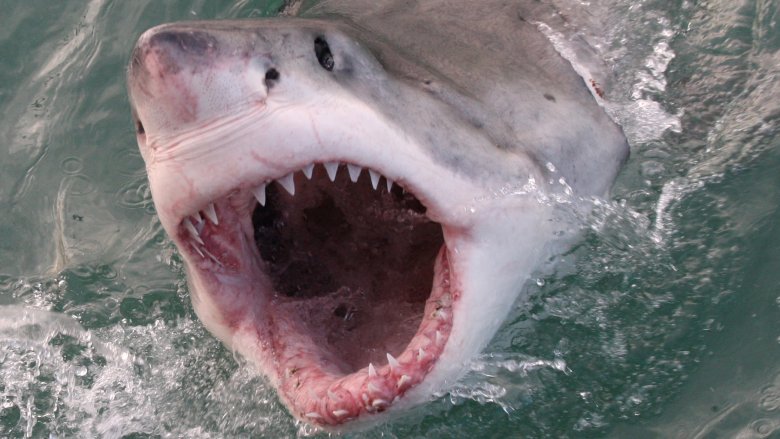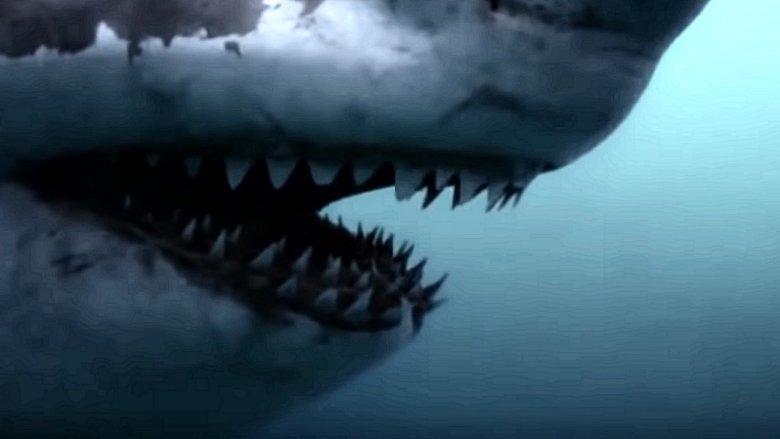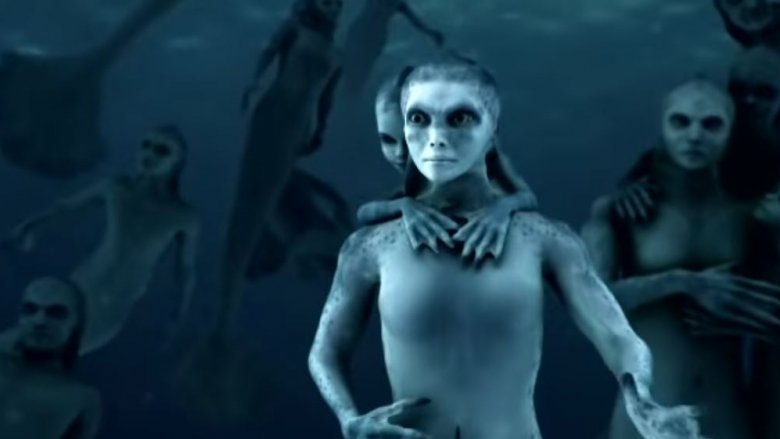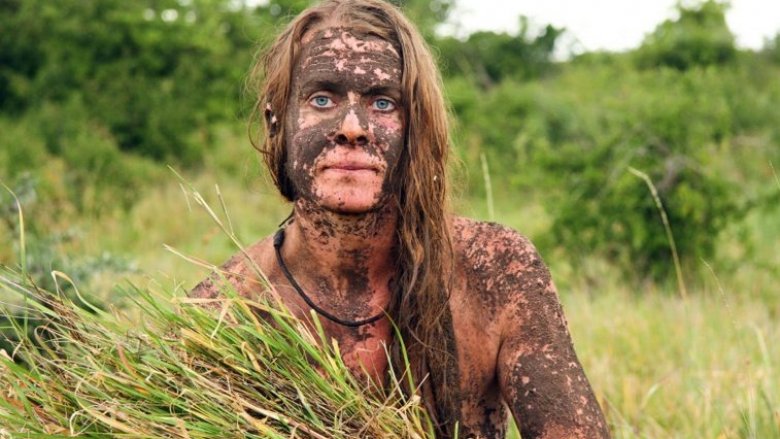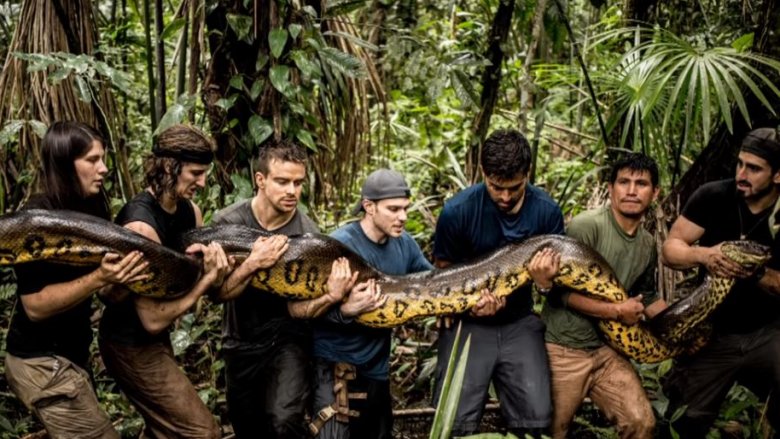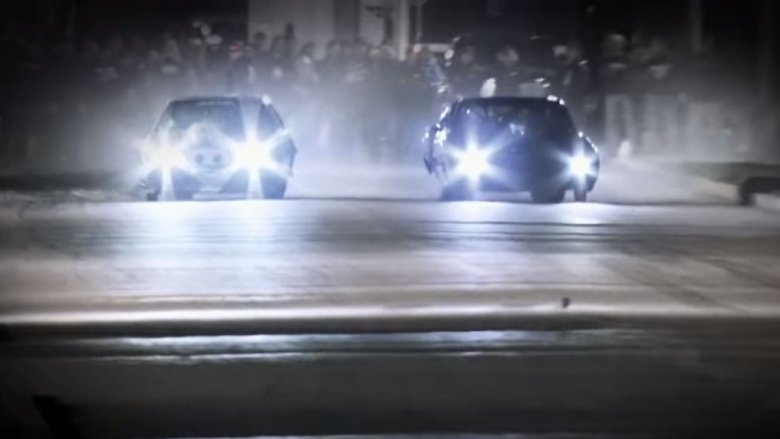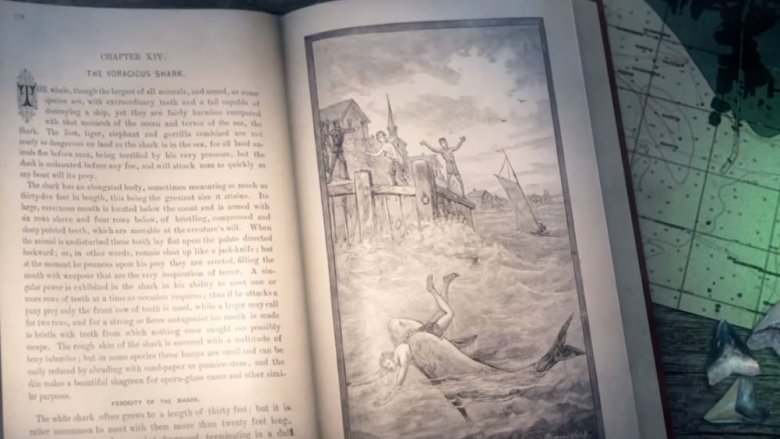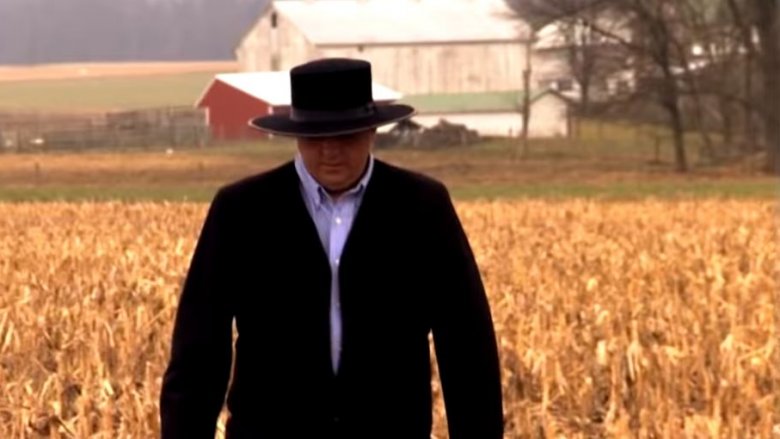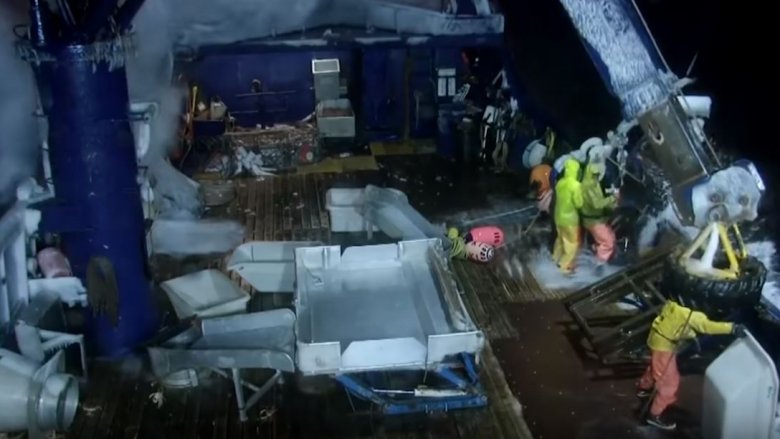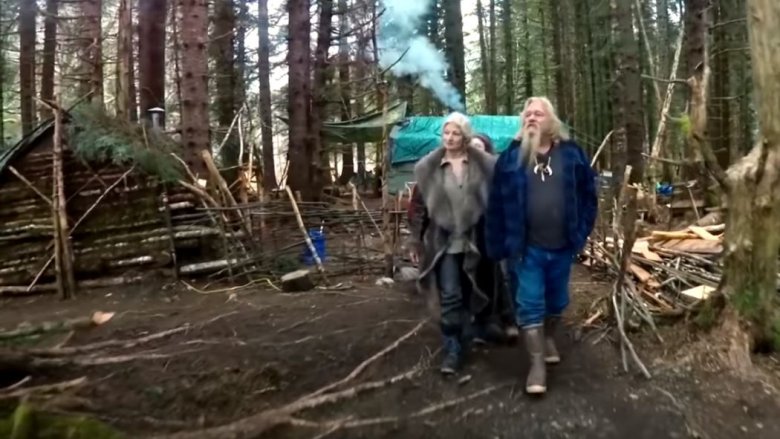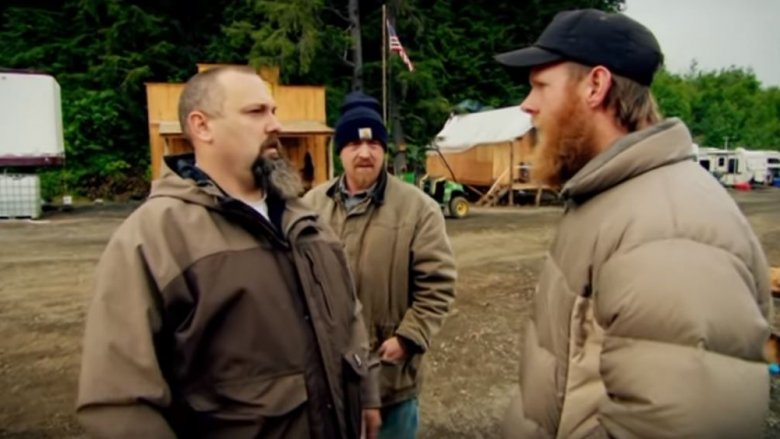Times The Discovery Channel Lied To You
If you've had it with all the dumb, fake "reality" shows on most TV stations, the Discovery Channel can seem like a beacon of true knowledge, education, and cool shots of sharks lunging at the camera. Okay, sure, Discovery has its own reality shows — and even some of those nature documentaries can be get a bit sketchy — but at least with Discovery, you feel comfortable knowing that most of what you're watching is based on genuine facts.
But, then again... not always. While the Discovery Channel has lots of valuable educational programming and Shark Week has become the undisputed Super Bowl of nature shows, the network has made some big missteps over the years, from portraying scripted segments as real, to pretending a guy got swallowed by a snake, to outright misrepresenting the views of real scientists in an effort to score big ratings for dumb programs.
When Discovery jumped the shark
Megalodon, a hulking beast that could grow 60 feet long and had the bite of a Tyrannosaurus rex, is the monster that will never die. Except it did die, millions of years ago, and the Discovery Channel keeps pretending to bring this extinct creature back to life.
Shark Week has become an institution, so it was pretty shocking in 2013 when Discovery kicked off the event with a special titled Megalodon: The Monster Shark Lives, a mockumentary pretending that the giant toothy zombie-fish was eating people off the coast of South Africa. Though the program did contain a shady warning about "dramatized events," CNN reported that huge ratings were followed by a furious public outcry, with many arguing that the fake documentary had damaged the credibility of Shark Week as a whole. Can't argue with that. Discovery continued this less-than-factual tradition the next year, with an equally phony sequel until finally cutting it out in 2016, according to Business Insider. Presumably, the scraps were fed to the sharks.
Come 2018, and for Shark Week's 30th anniversary, Discovery went back to the well. According to the Washington Post, the newest special, titled Megalodon: Fact vs. Fiction, is a bit different in that its entire goal is to fact-check the original program. Sounds like Discovery is embracing postmodernism.
Sorry, mermaids aren't real
No, there are no aquatic apes. Repeat, for those in the back: Aquatic apes are absolutely, 100 percent not real. Furthermore, even if primates evolved to survive underwater, why would they become half-fish? Actually, don't answer that. Mermaids only work in the world of fantasy, which is why the 2012 "documentary" Mermaids: The Body Found, which aired on Discovery's Animal Planet, caused such an uproar.
The problem? Both Discovery and Animal Planet are known for educational programming, not hoaxes, so sneaking in a fake documentary like this one, which claimed that mermaids were real creatures covered up by the U.S. government, is damaging to the institutions of science, facts, and society as a whole. Snopes debunked the whole thing, of course, but the scam was quite elaborate, featuring CGI sequences and even a URL, "BelieveInMermaids.com," which opened to a blank page claiming that the domain had been taken down by Homeland Security. Ooooh, creepy. There's nothing wrong with using a documentary/found footage format to create compelling fictional narratives, as films like The Blair Witch Project and the original Cloverfield demonstrate, but it's extremely important to make these intentions clear from the outset so casual viewers aren't misled.
Bear Grylls roughed it out in luxury hotels
Bear Grylls is one rugged dude. If you watched his Discovery TV program Man Vs. Wild, you'd be amazed to see him survive — with a smile on his face! — through crazy weather conditions, animal attacks, and a diet of giant larvae and bugs. Sleeping outside in harsh natural environments, too? Yikes. What you don't see on TV, according to the Telegraph, is that when filming wrapped for any given day, Grylls actually slept in luxury hotels.
Sorry to break the illusion. As the New York Times explains, some of the woodland terrains Grylls was forced to endure included a resort advertised as a "cozy getaway for families" with such life-threatening hazards as a hot tub, a stone fireplace, a television, and internet access. Scary stuff. Lest you think that's the only deception going on in TV land, another example of filmmaking trickery happened in the episode where Grylls built a raft out of bamboo, hibiscus twine, and palm leaves, allegedly with his bare hands: In reality, he was in charge of a team of builders. But hey, that would ruin the narrative.
To Grylls' credit, he ended up apologizing for all this fakery, according to the BBC, and promised to do better by his viewers in the future.
Oops, those dancers aren't from Malaysia
Never doubt the power of TV commercials to escalate violent tensions between countries. No, seriously. Back in 2009, an ad aired promoting the Discovery program Enigmatic Malaysia. The series was meant to highlight Malaysian culture, and the ad featured a traditional Pendet dancer. Just one problem, according to the Seattle Times: The Pendet dance comes from Indonesia, not Malaysia. The Malaysian government was blamed for Discovery's mistake and was accused of attempting to hijack Indonesian culture, erupting in an explosion of Indonesian protests, arrests, Malaysian flag burnings, and egg throwing. One nationalist group attempted to collect signatures for a petition to go to war.
To be clear, the commercial didn't start these tensions out of nowhere. Conflict between the two nations has a long and bitter history, which continues to this day. But the Discovery ad did ignite a vicious new spat, for sure, as the Jakarta Post explains. The true fault lay not with the Malaysian government, but rather, with the Discovery Channel for not paying enough attention before running the commercial. Despite claiming to be uninvolved, the Malaysian minister of tourism sent his Indonesian counterpart an apology letter, according to the Jakarta Globe, which the Indonesian minister proclaimed as being inadequate.
Naked and Afraid and Deceptively Edited
Discovery's Naked and Afraid is the kind of show that producers come up with when they get drunk, fawn over Survivor's ratings, look up naughty websites on their work computers, and then wonder how they can combine it all for big bucks. No guarantee that the show originated like that, but it's a fun story to tell. And like any other reality show, the word "reality" needs those quotation marks because Naked and Afraid is phonier than a streaker in a flesh-colored jumpsuit.
Yes, those people really are naked, they're sleeping outside, and they really do survive some nightmarishly intense situations, but there's a lot of staging involved. For one, the contestants aren't anywhere near as isolated as they appear, as former contestants have reported running into local townspeople playing soccer or even hearing club music at night. Two, the producers have a bad record of torturing their contestants and using editing tricks to hide their tracks. According to former participant Honora Bowen, her episode was sadistically edited to make it look like she had pubic lice — she didn't — and producers exploited the recent loss of her father with a fictional storyline about an ordinary magnifying glass. According to Channel Guide Magazine, another contestant, Phaedra Brothers, got food poisoning from a meal prepared by a member of the crew, right before shooting commenced, and the editors edited the episode to make it look like her illness was the result of drinking untreated water.
The dude who (didn't) get eaten by an anaconda
Hey, remember when the giant snake swallowed Jon Voight whole in the 1997 thriller Anaconda? Have you ever wanted to see the same thing happen to somebody in real life? Whoa, whoa! You're kind of a sicko there, huh? However, it seems the Discovery Channel was listening to your deepest, darkest desires, and in 2014 they did a huge marketing push for their special Eaten Alive, according to Vox, claiming the program would feature a guy named Paul Rosolie being ... you know, eaten alive. Yes, by an anaconda, and no, he wasn't planning to die. He was outfitted with a special high-tech suit. How would they remove him, after being swallowed? Well, let's just say the method (or the swallowing itself) wasn't going to be so healthy for the anaconda.
Or the viewers, for that matter. After marketing the show like crazy, anyone who tuned in had to push through two hours of highly staged material, culminating in Rosolie getting constricted, almost having his arm broken — and then tapping out. Good for him, and good for the poor tormented anaconda, but who ever greenlit this stupid idea?
Street Racers works with the police
Why is a show about illegal street racing on the Discovery Channel to begin with? Who knows. However, Street Outlaws purports to document real, unlawful, dangerous street races in Oklahoma City. Actual street racing is a remarkably irresponsible activity, totally different from the fantasy scenarios in the Fast & Furious movies. Bystanders can be killed and property can be ruined, which is why the National Hot Rod Association threatened to revoke the license of anyone who appeared on the show, according to Jalopnik. So how can Discovery film the series without getting in trouble with law enforcement?
The answer? Because law enforcement works together with the show, duh. According to Oklahoma's News9, Street Outlaws was caught employing police officers to shut down stretches of road so they could film the racing scenes. Not just tiny neighborhoods, either: The cops shut down an entire section of State Highway 81, in Union City, just so that a ridiculous little TV show about supposedly illegal races could legally film those races. The highway was blocked off for 10 hours (sorry to anyone else who wanted to use the road) for the royal price of $25. It sounds like something from a dystopian novel, but it's just real life.
When they made a scientist look like he supported a crackpot theory
Ever since Jonathan Davis was a kid, he dreamed of one day appearing on Shark Week. As an adult, he became a notable marine biologist and was totally jazzed when Discovery knocked on his door and asked to film his exploits. Little did he know, according to NPR, that he was about to get screwed over.
The first sign that something fishy was going on came when the crew filmed Davis' team pulling sharks out of the water and tagging them for real scientific research, and a producer asked Davis to let the shark bite him for ratings. Davis refused because he is a human with a brain. According to Gizmodo, the film crew repeatedly refused to answer Davis' questions about how the footage would be used. Finally, at the end of the shoot, Davis was asked if he believed in old stories of a mystical "voodoo shark" called the Rookin, which allegedly prowls the Louisiana bayous. Being a scientist, David laughed this off.
Months later, Davis had the not-so-happy realization that his footage was being featured on a TV program titled Voodoo Shark, with his interview edited to make him look like a die-hard Rookin believer. To rub salt in the wound, the footage itself was cut to make it appear like his crew was racing against a team of Bayou fisherman to catch the Rookin (sometimes spelled "Rooken"). This is impressive because Discovery managed to disappoint an old fan and spread misinformation at the same time.
The Amish shouldn't even be on camera anyway
It should be obvious that Amish Mafia is faker than fake, considering that the whole idea of a group of dedicated Amish people signing up to be followed by TV cameras is wildly against their whole shtick. How artificial is the series, though?
Although the program hides behind claims that the so-called Amish mafia operates so "under the radar" that their very church denies their existence, Snopes points out that it's entirely possible, or even probable, that everything on the series is staged. While the credits do warn of "select reenactments," the series never says which sequences are supposedly true, which is fairly suspicious. Furthermore, it seems pretty ridiculous to imagine that anyone would so openly break the law on a TV program, as the stars do in the show, by doing things like breaking into motel rooms or shooting out of car windows. If you want a more realistic look at Amish life, drive down to Pennsylvania or maybe try PBS.
Deadliest Catch faked a storm
A 2008 episode of Discovery's Deadliest Catch contained a frightening sequence in which an Alaskan crab fishing boat named the Wizard is forced to fight through nightmarish storm conditions. Waves crash over the deck. Water floods the insides. It's a perfect storm! Will they survive?! (They do, of course.) However, though the Wizard certainly did go through some big waves, the Hollywood Reporter sussed out some problems with the show's narrative. The scenes of the boat flooding were shot in September, while the storm waves didn't hit until October. These unrelated events were cut together to make a more perilous scene.
Creative license, sure, okay. But again, if you don't tell your audience that you are using creative license, it suddenly becomes deceptive when your program is marketed as a documentary. That said, this is pretty earnest as far as these sorts of TV deceptions go, especially when compared to some of the more deliberately falsified reality shows out there.
The Alaskan Bush People don't live in the wilderness
Alaskan Bush People might portray its stars — sorry, would "actors" be a more accurate word? — as living rugged, old-fashioned lives in the desolate wild north, far away from the contemporary world, but this is far from the truth. Alaska's famous wilderness does make it possible to live far away from other people, but the Brown family certainly doesn't. Sure, they have bears and deer roaming about, but Anchorage Daily News points out that the Browns' oh-so-secluded residence was only a dirt trail away from the highway and a half-mile from a pizza place. Hey, how about heating up a slice of pepperoni with your campfire? On top of that, the nearest neighbor was apparently so close to the family's house that he got insanely frustrated with the TV production's constant chainsaw noises, vehicles, and helicopters, to the point that he even fired fireworks into the sky to shoo the chopper away.
Now, nobody's advocating for that kind of response, but neighborly squabbles are awfully suburban. Another deep cut to the show's authenticity is that the entire back story of how the family's old house was "burned down by the government" is highly dubious, according to Channel Guide Magazine. Notice that important details like whether the family actually lived there or whether the cabin actually went down in flames were noticeably underreported on.
Gold Rush is staged
Yet another reality show that's sadly lacking in reality, Gold Rush supposedly chronicles the day-to-day lives of professional gold mining families. Fair enough, but real life isn't scripted — unlike Gold Rush.
According to Inquistr, former cast member Jimmy Dorsey has come out and admitted that the show is planned, scripted, and directed from the beginning, with certain cast members intentionally acting out to create dramatic situations. According to Dorsey, even his big exit from the show was arranged. He had no intention of leaving, initially, but Discovery producers fed him lines about needing to find gold in 70 hours and then steered him out of the show through careful manipulation of events. Dorsey also said the editors cut about 90 percent of the positive interactions and events captured during filming, but hey, that's to be predicted: nice, pleasant conversations don't make for entertaining TV or good commercial breaks, even if they are more realistic.
